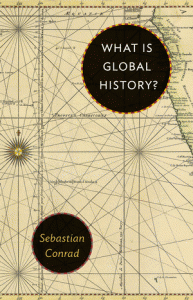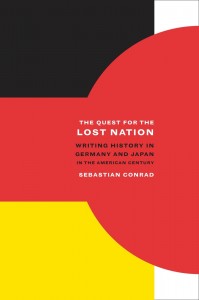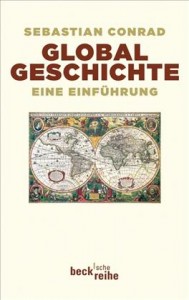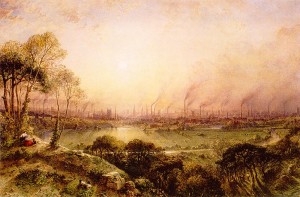Global History as Past and Future: A Conversation with Sebastian Conrad on "What Is Global History?"
It's a common question that teachers of global history face. We belong to one of the most quickly-moving, contested, and changing subfields within the historical profession, and the travel schedules on many of our dockets—Istanbul one week, Tokyo the next—make our colleagues who slave away in the same provincial state archive blush. The years spent learning foreign languages begin to pay off, as one can not only read the newspaper but also foreign colleagues' peer review comments on an article scheduled for publication in this or that journal. Life, it seems, is good.
But when it comes time to teach global history as a field, one hesitates. For audiences of graduate students, of course, it's possible to follow the tactic of assigning a pile of monographs bringing global history perspectives to different regions of the planet: China the one week, the Gambia the next. But how to put it all together into one common language that speaks to the Americanists and the East Asianists in one seminar? Worse yet: how to teach this all to undergraduate audiences for whom the monograph approach would incite revolt?
 Fortunately, as we've noted in earlier installments of the Global History Forum, scholars of global history who formerly had to throw their hands up in response to this dilemma increasingly have at their disposal an array of good introductory works to the field. One might only think of the work of Diego Olstein, for a recent work in just this niche in English, or, for German-speaking audiences, a 2011 book that fills the same need by Austrian economic historian (and former TPF interviewee) Andrea Komlosy. At the field grows and becomes more sophisticated, though, so, too, are the options for introductory texts expanding. One of such works constitutes the focus of this installment of the Global History Forum, namely the aptly-titled What Is Global History? (Princeton: Princeton University Press, 2016) by Professor Sebastian Conrad, the Chair in Modern History at the Free University of Berlin.
Fortunately, as we've noted in earlier installments of the Global History Forum, scholars of global history who formerly had to throw their hands up in response to this dilemma increasingly have at their disposal an array of good introductory works to the field. One might only think of the work of Diego Olstein, for a recent work in just this niche in English, or, for German-speaking audiences, a 2011 book that fills the same need by Austrian economic historian (and former TPF interviewee) Andrea Komlosy. At the field grows and becomes more sophisticated, though, so, too, are the options for introductory texts expanding. One of such works constitutes the focus of this installment of the Global History Forum, namely the aptly-titled What Is Global History? (Princeton: Princeton University Press, 2016) by Professor Sebastian Conrad, the Chair in Modern History at the Free University of Berlin.
Billed as a "problem-oriented" approach to global history that provides much-needed criticism and pauses alongside enthusiasm, Conrad's What Is Global History? appears at just the right time for a field in much need of explaining itself to students—and to critically interrogating its own limits. Recently, Toynbee Prize Foundation Executive Director Timothy Nunan had the chance to speak with Professor Conrad to discuss his recent book and what he sees as the biggest challenges facing the field as it matures and grows in years ahead.
•
We start our discussion by asking Conrad about his road to history as a profession. There was, he explains, nothing foreordained about his becoming a historian. He grew up in Heidelberg, a university town in southwestern Germany, and while there were history books around the home, he jokes that his first grades in history classes in school were among his worst. Pursuing a career in law seemed more likely than something academic. It was, instead, early trips abroad that began to open Conrad's horizons. As an adolescent, he spent a year abroad in the United States. Later, while doing his Zivildienst (a year of public service, mandatory at the time for German citizens who exercised their conscientious objection to military service) he lived with a Japanese family in Heidelberg for a year, opening his eyes to that culture and language.
Soon it was off to Bonn, where he pursued the equivalent of a double major in History and East Asian Studies. Throughout these years, in addition to honing his language skills, he began building and maintaining contacts with Japanese colleagues in Osaka and Tokyo, adding to the American contacts that his previous immersion in the United States facilitated. We ask Conrad if he would have any tips for Bachelor's or early doctoral students going through the process of deciding if an academic career is right for them.
"Do your own thing!" he laughs. "You have to have a fire in your belly if you're going to complete a major project." There may be a significant amount of caprice and happenstance that guides or derails plans in academia, but one has to be doing a project for themselves if they're going to maintain enthusiasm about the work. The trick is balancing that inner drive with paying attention to where various fields are going.
To these skills Conrad adds that people interested in working on projects with a global history perspective need to put the time in to engage with sources and scholarship from other regions of the world. Indeed, as Conrad moved to the Freie Universität Berlin to pursue his first dissertation (in German, Promotion and the equivalent of an American PhD) under the supervision of Jürgen Kocka, he found inspiration not only from the camaraderie of other Kocka students working on more traditional German history topics, but also the Japanese scholars with whom he discussed his work. He began writing a dissertation examining how postwar German and Japanese historians struggled to reclaim and redefine the national past in the wake of total defeat.
Facility with the Japanese sources plus those in Conrad's native German was obviously essential for the project, but, he adds, "it was often the comments of Japanese scholars that helped me rethink the project at critical junctures. I might have determined that some early version of the project was possible," he explains, "but it was in seminars with Japanese scholars that I was pushed to rethink it in a way that it would be interesting." Hence the lesson: learning foreign languages isn't just some paleographic skill, but rather often the gateway to different scholarly perspectives and conversations only taking place in Tokyo, Istanbul, or Sao Paolo, as the case may be.
The next several years saw Conrad expanding his scholarly profile. In the German capital, he began working on a second dissertation (a Habilitation, a kind of PhD on steroids required to be employed as a full professor in German universities) that eventually became (first in German in 2006, then in English in 2010) Globalization and the Nation in Imperial Germany, thus appearing in the same year as the English translation of his first book, The Quest for the Lost Nation: Writing History in Germany and Japan in the American Century (UC Press).
In writing these and other works, Conrad belonged to a larger shift in priorities towards global history present not only in Germany but also the rest of the world. He co-edited a volume with the noted scholar of global history (and, perhaps not coincidentally, also a historian of East Asia by training) Jürgen Osterhammel on trans-nationalizing German history, co-edited another volume with Toynbee Prize Foundation President Dominic Sachsenmaier (also a German historian of East Asia) on alternative visions of world order, and later wrote a short history of German colonialism (appearing in German in 2008 and English in 2012).
With this spate of publications came, predictably, new positions: Conrad moved from Berlin to the European University Institute in Italy in 2007, and then, following three years in Italy, assumed the Chair in Modern History back at the Freie Universität Berlin.
During these peripatetic years, Conrad began publishing on the field of global history, playing a crucial role in introducing the field to German audiences. He co-edited books and wrote articles on the subject with fellow scholars of transnational processes, like the historian of Africa Andreas Eckert, holder of the Chair in African History at the Humboldt University in Berlin. And in 2013, Conrad's Globalgeschichte. Eine Einführung (Global History: An Introduction) appeared with the German publisher C.H. Beck. Soon, Conrad came upon the idea of translating Globalgeschichte for an American audience, and proposed the idea to Princeton University Press. Most of the reviewers of the idea approved, but one or two voices pushed Conrad not just to translate the text into English but also to re-work the book as a more in-depth engagement with problems in the field.
Conrad balked for a moment. Obviously, re-writing the book substantively meant a lot more work. "Further," he notes, "this is such a fast-moving field that any programmatic statements I would have to make ran the risk of looking outdated five years down the road." Still, he accepted the challenge, trying to write a text, in his words, that was less of a schematic overview of the field and more of a "problem-based approach" to issues that had become clearer in the mere one or two years since he sent off the German manuscript to C.H. Beck. Not only were many scholars and colleagues completing monographs, but also new edited volumes like Samuel Moyn and Andrew Sartori's Global Intellectual History raised new problems such as how to explain the non-globalization or proliferation of ideas, even as material connections would appear to have made such transfers natural, if not inevitable.
Soon, then, Conrad was back to the drawing board, delving into some of the outstanding problems that any serious engagement with global history would have to acknowledge if not answer. Suffice to say that the result in What is Global History covers much ground. Some chapters touch on what one might call the scales of time in the writing of global history (in German, Zeitschichten) – that is, how we reconcile narratives that explain change in short-term timeframes (say, involving a change of political administration or a changed policy) with those that explain change over time through longer-term timeframes (the effects of religious conversion, say, or climate change). Other chapters touch on the ethics of position in writing global history (e.g. do we risk replacing Eurocentrism with Asia-centrism?). And others still address the ways in which integration and connection happen and engender global history perspectives (think empire and technology, but also of factors like the spread of certain diseases through plant or animal vectors).
For the purposes of our conversation with Conrad, and this piece, we could only cover a few aspects of what remains a wide-ranging book. Still, we dive in by asking Conrad a basic question that might be on the mind of neophytes to the field: need "global history" encompass the entire world? The entire planet?
The answer to this question, Conrad explains, depends on when in the history of global approaches you are asking about. Earlier in the twentieth century, he notes, when the belief in the universal applicability of modernization theory or Marxism-Leninism was widespread, it was ideologically unproblematic to conceive of the planet in terms of a mosaic of different nation-states that were all marching towards the same goal: progress, modernity, or the democratization of the means of production. The key word was "totality," and as such, "global history" meant taking in the entire planet in order to tell stories like the rise and fall of civilizations, or the formation of a Europe-centric world system that doomed its peripheries to the role of commodities suppliers.
But, Conrad explains, with the advent of more critical perspectives that rejected the applicability of modernization theory or socialism as a universal path, it became harder to hold on to such schemes of the planet as the historian's canvas. Scholars became more sensitive to the vernacular ways in which actors envisioned the future as a political concept (not always oriented towards some unproblematic ideal of "Europe"). Even as the end of the Cold War and the uptick in global economic integration that followed it meant an increased visibility of the way different parts of the planet were connected with one another, scholars in the late 1990s were more and more skeptical to see "globalization" as a master narrative into which specific national or local histories could be shoehorned.
Today, notes Conrad, the works that interest him the most are those that marry a global perspective to the histories of specific places. They can be works like Andrew Sartori's Bengal in Global Concept History, which explore the emergence of concepts like "culture" in the non-Western world; or books like Donald Wright's The World and a Very Small Place in Africa, which explore the inflections and entanglements of very specific places (here, the Gambia, in western Africa) with structural change. Overall, this shift means less armchair philosophizing and more grounding in specific places with specific (and often non-Western) languages, archives, and concepts—all good things for the sophistication of the field.
Hence, Conrad notes, his use of the term a global history perspective, rather than there being some hegemonic concept of "global history," is advised. As he notes in What is Global History?, there has been criticism from certain quarters alleging that global history is "the ideology of global capitalism," designed to celebrate an integration that often involves the creation of profound economic inequalities. And as scholars like Dipesh Chakrabarty—the 2014 Toynbee Prize winner—have noted, a rush by scholars in wealthy Western countries to embrace global history qua discipline risks deepening the "inequality of ignorance" around the world. Not only is the language acquisition and far-flung archival trips associated with global history projects expensive; more than that, the very commitment to a global approach often stands at odds with national sentiment in countries like, say, Ethiopia or Nigeria for which the achievement of nationhood and independence is more rickety than elsewhere.
Conrad's point, then, is that fears of a clash between wealthy Western academics asserting the superiority of a monolithic global history approach and scholars from Latin America, Africa, and Asia being reduced to the rule of native interlocutors to this project are overblown. By using the phrase global history perspective, Conrad stresses that "global history" is just that—an attention to connections and entanglements that can enrich the study of individual places and help re-conceptualize national history beyond the study of everything that happens within lines on a map.
The way we think about Russia, for example, might change when we think of it as part of a "Muslim world," what with its tens of millions of Muslim citizens; likewise, a concept like "Pacific history" or oceanic histories in general might help us bind together the study of places like Mombasa and Mumbai, or the Phillippines and Los Angeles, that might not necessarily be written together. Finally, though, Conrad concedes that as a perspective, global history need not be programmatic. There are subjects for which a nationally-bound perspective–struggles at court, say–is perfectly appropriate.
Moving on in our conversation, we discuss with Conrad another issue that he deals with at length in What Is Global History?, namely that of verticality and power as a counter-point to horizontality and connections. What is actually new about global history today in contrast to earlier upswings in the fashionability of the concept, we ask? And are there risks involved in too much embrace of connections between unexpected locales?
Conrad provides a bit of historical background before developing his answer. We didn't move from Arnold Toynbee to the transnational approaches of today in one fell swoop, notes Conrad. For much of the 1970s and 1980s, he reminds us, comparative history was much in vogue. Historians asked why there was no socialist revolution in Germany but one in Russia, or why England had an industrial revolution where China had none.
But, reminds Conrad, over time the limitations of this approach—still often indebted to the assumptions of modernization theory of a universalist march forward—became clear. Not only did the awkward device of comparative history tend to flatten the heterogeneity inside various national cases (the revolution was not everywhere in Russia, and the Industrial Revolution happened in specific parts of England). More than that, the conceit of comparison also tended to reinforce ideas of national Sonderwege—"special paths—thanks in large part to the set of comparisons devised in the first place. How "special" Germany's path was in history, to take the paradigmatic example, depends a lot on which European countries one compares it with—assuming one accepts the Eurocentricity of the Sonderweg paradigm in the first place.
For all of these reasons, Conrad notes, over time, historians interested in embedding a more global perspective in their work turned less to comparisons and more to connections. Perhaps still the dominant approach today for what goes under the heading "global history," many a graduate student now traces the transnational traffic in ideas, commodities, plants, animals, and minerals —assuming that the label "transnational" is really appropriate for exchanges that often happened within empires.
But, as Conrad interjects in What is Global History?, there are risks to this approach. "Connections," he explains, "are more often the result of power than they are its cause." Effective global history, he explains, has to remain mindful of the big structures (often imperial and "vertical" rather than micro-historical and "horizontal") that engendered exchange.
This might sound abstract, so in the book Conrad goes into more detail. "When critical intellectuals in Vietnam, Japan, or China began to read Marx," he explains, "this was, rather logically, seen as evidence of the transcultural circulation of ideas. Accordingly, traditional histories charted the translation process, studied the reception of Marxist ideas, and looked for the impact of Marx's texts on reformist thinking in Asia." So far, so good.
But there are potential trip-ups in this approach. Conrad explains. "While these were important facets of the problem, the more important causal links lay elsewhere. In this case, connectedness proved to be itself the result of social changes that had created the conditions under which reading Marx in Vietnam began to make political sense. In the last instance, the influence of Marx could not be reduced to the power of his arguments alone. Rather, aspiring young intellectuals were shaped by the forces and concerns that dominated the times, and the way in which they translated, cited, and highjacked Marx's texts was structured by these conditions. Connections–reading Marx–were thus primarily an effect of prior social, political, and cultural transformations (and not the source of these transformations)."
Rather than merely investigating the naked fact of connection—however much rich philological and archival work that may involve—Conrad's stress is that we need to investigate the conditions of possibility as well. The emphasis is on "possibility," not necessity, too. As Conrad notes later, "not everything moves and not everyone travels." Alongside our ready-at-hand language of connections, flows, and entanglements has to come a more skeptical vocabulary of blockages, friction, and fractures. This applies both to ideas as well as commodities that did not move around within imperial structures.
Take, for example the peacock flower, a contraceptive and abortifacient used by slave women in Latin America and the Caribbean in the 18th and 19th century. Even as the peacock flower was used by women to abort offspring so that they would not pass into a system of slavery built around the circular motion of African bodies, Caribbean sugar, and European capital, the humble peacock flower stayed put on the islands. Why? Historians, Conrad stresses, need to pay attention to these issues of non-connection and non-integration even as they also note instances of flows.
But what if our language itself barely captures these flows? It is with this in mind that we turn to the final aspect of our conversation with Conrad, namely that of conceptual history. Conrad explains the conundrum: "often when we write histories, we use concepts that are not emic—that is to say, not originating from the social groups being studied. Many of the concepts we use to study the world are not only European in origin. More than that, they are of comparatively recent vintage: the concept of "religion" as we know it today, for example, dates to the early nineteenth century. So what are the distortions involved when we use concepts like religion to study phenomena like Confucianism, which – without a church structure, and without the idea of a transcendental god - does not seem to fit the definition of the term? What conceptual violence do we inflict on our subjects if we dub political arrangements like the Commanche Empire, or the Mongol Empire, with a term, "empire," that they never used themselves? These might seem like academic quibbles, but when one considers the claims made by Chinese nationalists today that Confucianism represents an entire alternative epistemology with its own concepts to rival those of "the West," the political stakes involved here become clear.
Conrad seeks a middle ground in this debate. Attempts to claim a "Chinese epistemology" or a "Russian way of thinking" have to be viewed with skepticism, insofar as they run counter to what Conrad calls "the ecumenical and dialogic inclinations of global history as a field." We can recognize the claims of different national groups to inhabit different cosmologies, but we still need to be able to speak with one another across such life worlds. The best move might be to acknowledge, as has Dipesh Chakrabarty, that certain concepts might be "inadequate but indispensible"—concepts like "religion." At the same time, there remains the hard work of seeing how Western concepts like "religion" or "culture" interacted with local interlocutors and their agendas. It may very well be the case that Mongol or Commanche epistemologies had their own, different concepts for what we would dub "culture," "identity," or "statehood," but we still have to acknowledge the reality that those cultures were forced into intercourse with those Western concepts. These encounters and incorporations constitute valuable intellectual histories in their own right. More than that, too, they are also an essential context for understanding the ways in which these concepts have an afterlife in the social science produced in places today like Iran, India, or China.
Conversely, notes Conrad, we might adopt more skepticism toward some of the concepts that frame many works of global history today. Take one like "migration." We have to be careful, Conrad notes, in using the term as a catch-all for very different processes of human motion. More fundamentally, though, he notes that the term "migration" is often associated with some kind of border-crossing, a process that itself tends to reify the nation-state as a prime locus of migration histories.
There might be good practical reasons for doing so–archives, for one. But, notes Conrad, such a perspective "renders a short move from Tijuana to San Diego 'migration,' while the much longer journey to Guadalajara earns no such terminological dignity. Any focus on migration thus implicitly rests on assumptions about the difference between everyday forms of movement that can remain unmarked, and other forms of mobility that involve the crossing of boundaries and state borders and that historians therefore recognize as migration." Rather than taking the historical category of "migration" as a given, then, we need to recognize the way in which the very concept itself (apparently a creature of the mid-18th century onward) was developed as a tool "linked to the overlapping projects of nation-building, imperialism, and labor recruitment." This does not necessarily mean that historians of the U.S.–Mexico border must give up their projects. But it does mean that those histories would be greatly enriched through an engagement with the ways in which the very terminology used by border agents and customs officers generated the phenomenon of "migration" itself, rather than the other way around.
As noted above, these are just some of the themes in a relatively compact (312 pages) but rich book. Elsewhere in the pages of What Is Global History?, Conrad engages at depth with questions like responsibility in global history, or the intersection of different scales of time in the writing of global history. The search for the intersection of connections and structure, for example, may sometimes run the risk of obscuring agency in problematic ways. When we write the history of the Holocaust, one could adopt a global history perspective that might emphasize long-term trends of anti-Semitism or the place of Jews as citizens and subjects in the lands where so many were to be murdered in the 1940s. But does writing history on these bigger scales obscure individual decision points? Does it erase responsibility?
Another question taken up in What Is Global History?—and, in all likelihood, classroom discussions—has to do with the intersections of different scales of time when talking about causation in history. Consider the post-1970s economic rise of China, and how we explain it. On one level, one can clearly tell a story of medium-term causes, such as the economic reforms of Deng Xiaoping and the late Cold War alliance between the United States and China that allowed Chinese producers to re-enter the global marketplace.
On the other hand, one might adopt a longer-term perspective to question what "normal" is for China's place in the international economy. Looking to classics like Kenneth Pomeranz's The Great Divergence, one might note that China's current leading place in the international economy is actually the return to a norm from which China only "diverged" in the 18th century. Both of these approaches are not obviously incorrect on their face, but explaining how they intersect and stand at a certain tension with one another must belong to the task of those writing Chinese history in a global perspective. How do we write that history, though?
These questions abide—but students and teachers looking to dwell on them as they formulate their own projects would be well-advised to pick up Conrad's What Is Global History?
•
As our conversation comes to an end, we ask Professor Conrad about what works in the field of global history have inspired him recently. He responds with a few outstanding books. One, Jason Ananda Josephson's The Invention of Religion in Japan (Chicago: University of Chicago Press, 2012), represents an ambitious foray into the kind of global conceptual history that Conrad calls for in What Is Global History? In that book, Josephson explores how the appearance of the concept of "religion" in nineteenth century Japan, in the form of unequal treaties with Western powers that stipulated "freedom of religion," changed spiritual life in Japan for decades to come. Some "religions," like Christianity or Buddhism, received special enshrinement within Japanese civil life, while other belief systems, like Shintoism, were deemed "superstitions"—or, in any event, not religions.
Along with Josephson's work, Conrad also highlights his colleague Michael Goebel's Anti-Imperial Metropolis (Cambridge: Cambridge University Press, 2014), which we featured on the Global History Forum this fall, and Pekka Hämäläinen's The Commanche Empire as books that have stuck with him for some time after reading. Indeed, if Goebel's work is an excellent example of how connecting histories happen within vertical arrays of power (namely, the imperial metropole), Hamalainen's work is an example of how historians can struggle with those "inadequate yet indispensable" categories like religion, or empire to describe phenomena that their subjects (here, the North American Comanche people) might not have used for their own polities.
After our conversation with Sebastian Conrad, however, we're confident that What Is Global History? may well join the stack of books on many a reader's nightstand. The speed with which the field changes makes introductions to the field—where it came from, and where it is going—indispensable. But at a time when the remit of "global history" seems to be expanding in size, Conrad's text is also especially helpful in sympathetically, but critically, asking, what the limits of a global history perspective are. It helps push the way forward toward more differentiated concepts and terms than the catch-all label of "the global" that so many use to describe their perspective today.
In both introducing readers to the field, but also making clear how much remains to be done, we are confident that it will find a wide readership in classrooms and beyond. We thank Sebastian Conrad for participating in this installment of the Global History Forum and for discussing What Is Global History? with us.






